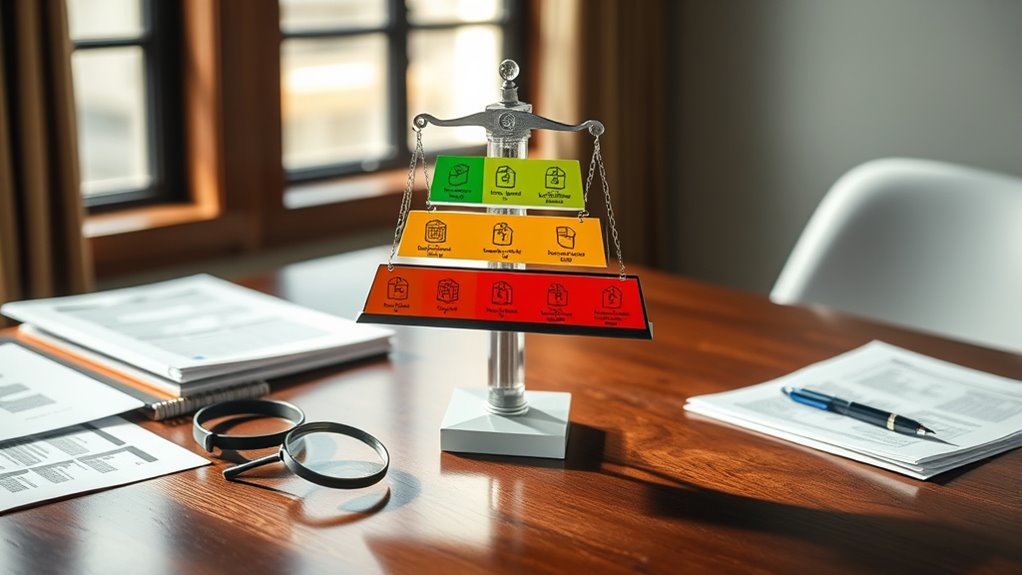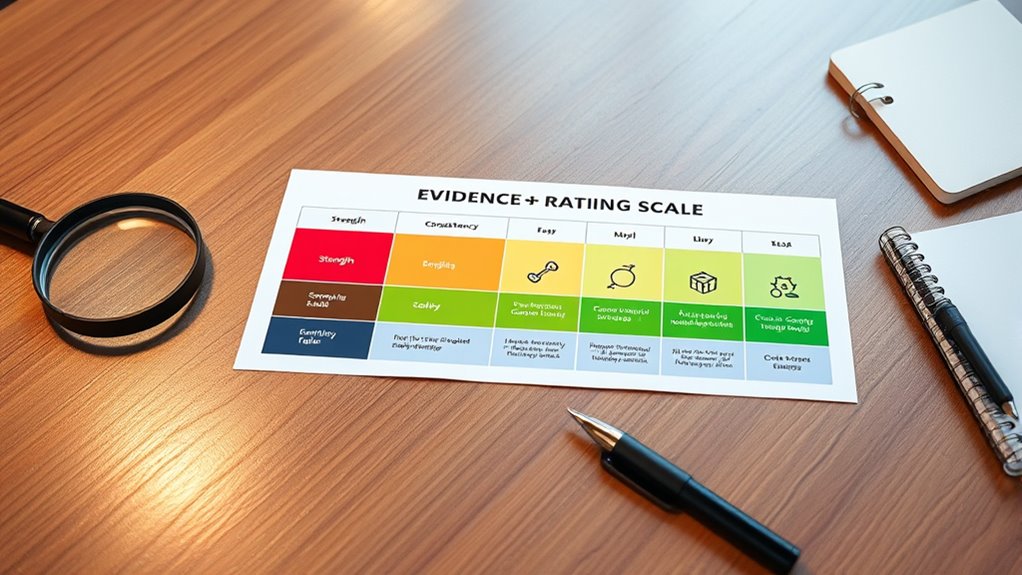Our Evidence Rating Scale evaluates research quality by focusing on study design, methodology, and transparency. You’ll find that we assess factors like participant selection, data analysis, bias control, and reproducibility. We prioritize rigorous designs such as randomized controlled trials and validated tools. Our goal is to make certain only trustworthy, robust evidence guides conclusions. If you want to learn how we make certain every study meets these standards, you’ll discover the detailed process that keeps our ratings reliable.
Key Takeaways
- We systematically evaluate each study based on its methodology, including participant selection, data collection, and analysis procedures.
- Our rating process emphasizes the use of rigorous study designs like randomized controlled trials and validated measurement tools.
- Transparency and detailed reporting are essential criteria, ensuring reproducibility and minimizing bias in assessments.
- We consider source credibility, including brand reputation and transparency, to gauge the trustworthiness of the evidence.
- The overall review applies consistent standards to differentiate high-quality, reliable studies from weaker or flawed research.

An evidence rating scale is a tool that helps you evaluate the strength and reliability of research findings and scientific studies. It provides a structured way to assess how well a study is designed and whether its conclusions are trustworthy. When we develop our evidence rating scale, we focus heavily on the study methodology, as this is the foundation that determines the quality of the evidence. The methodology encompasses everything from how participants are selected to how data is collected and analyzed. A well-designed study minimizes bias, controls confounding factors, and ensures that results are valid and reproducible. Conversely, flawed methodologies can lead to unreliable conclusions, so rating criteria are critical in distinguishing high-quality studies from weaker ones. We also consider the trustworthiness of the source, including brand reputation and transparency, to ensure the evidence we rely on is credible.
Our rating criteria are rooted in clear, objective standards that allow us to evaluate each study systematically. We look at whether the research employs randomized controlled trials, observational studies, or other design types, and then weigh their strengths accordingly. For example, randomized controlled trials generally earn higher ratings because they are considered the gold standard for establishing causality. We also assess the sample size, as larger, well-powered studies tend to produce more reliable results than small, underpowered ones. Additionally, transparency in reporting methods—such as detailed descriptions of procedures, statistical analyses, and potential conflicts of interest—is essential for us to assign a high rating.
We pay close attention to how the study methodology aligns with the rating criteria. If a study employs rigorous blinding, proper randomization, and validated measurement tools, it scores higher. On the other hand, if it relies on self-reported data without validation or has significant methodological flaws, its rating drops. Our process involves reviewing each study against these criteria to ensure consistency and fairness, making sure that the evidence we present is robust and trustworthy.
Frequently Asked Questions
How Often Is the Evidence Rating Scale Updated?
You’ll find that the evidence rating scale is updated regularly, typically based on new research methodology and evaluation criteria. We review and revise the scale at least once a year to guarantee it reflects the latest scientific findings. This way, you can trust that the ratings you see are current and accurate, helping you make informed decisions based on the most recent evidence available.
Can the Scale Be Customized for Different Research Areas?
You can definitely customize the scale for different research areas, tailoring it to fit specific needs. Think of it as a one-size-fits-all hat that you can reshape for area-specific adaptation. This research customization allows you to emphasize relevant evidence criteria, making evaluations more accurate and meaningful. So, don’t worry—adapting the scale for your unique research needs is both possible and straightforward, giving you the flexibility to get the best insights.
What Criteria Determine the Rating Levels?
The criteria determining rating levels focus on clarity and consistency. You look at how well the evidence supports each level, guaranteeing the criteria are clear and unambiguous. You also check that different evaluators would assign similar ratings, maintaining rating consistency. By applying precise standards and clear guidelines, you ensure the scale accurately reflects the strength of evidence, making it reliable and easy to interpret across research areas.
How Do You Handle Conflicting Evidence?
When you encounter evidence conflict, you carefully evaluate the sources and the quality of each study. If the conflict substantially impacts the overall understanding, you consider a rating adjustment to reflect the uncertainty or mixed results. This way, you ensure the rating accurately represents the strength of the evidence, acknowledging areas where findings diverge and maintaining transparency about the confidence level in your assessment.
Is the Rating Scale Publicly Available for Use?
Yes, the rating scale is publicly available for use. You can access it online, where clear usage guidelines are provided to help you understand how to apply it effectively. This transparency allows you to evaluate evidence confidently, knowing the scale is designed for broad accessibility. So, whether you’re a researcher or a curious learner, you can freely utilize the scale and follow the guidelines for accurate assessment.
Conclusion
Now that you’ve seen how our evidence rating scale works, imagine how it could transform your decisions. Every piece of evidence you evaluate is like a puzzle piece, hinting at a bigger picture. But the true clarity only emerges when all the pieces come together. Are you ready to unleash the full potential of your insights? The next step awaits—dive in and discover what’s possible when you master our rating scale.









